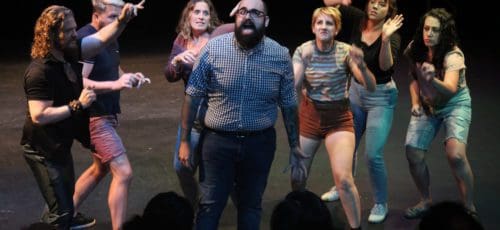Independent Artist Spotlight: Ani/MalayaWorks’ Nanay
Like water flows from a source, the performers of Nanay eb and flow through a ritualistic piece of movement research, revealing strong roots of womanhood and their own migrations as Filipinx Americans of various generations.
Nanay, Tagalog for mother, is a femme-centered exploration and appreciation of Nanays (mothers) and Lolas (grandmothers) as integral parts of family and culture throughout Filipino migration histories. Performer and activist Ani Gavino created Nanay under her group Ani/MalayaWorks Dance, a collection of Filipinx/a dancers and artists representing their own stories through movement art. “I’ve been dancing other people’s visions, and also other people’s stories, and no one’s really representing our stories, which is pretty much my motivation” explains Ani, their collaborators agreeing that they have all experienced a lack of Filipinx representation in art and dance, specifically. Isa Mojares, Sevon Wright, and Malaya Gavino share their own experiences with their varying identities in the Filipinx community, and how collaborating on Nanay has allowed these identities to come to the foreground. Isa explains, “We all kind of are looking for something different in the collaborative, but also getting something different out of it”.
 Ani began Ani/MalayaWorks as a platform for them and their daughter, Malaya, to create movement art and tell their own stories, as a Filipinx mother and first-generation American daughter. “It started with us first, but then we expanded, creating pieces where I can archive our stories using different modalities. And also honoring the complexities of our identities as one foreign-born immigrant, and having that experience of navigating the U.S. and indoctrinating myself into this culture, and what losses I’ve gone through. And then also the questions that rose when I had her… Who am I bringing into this world? What kind of complexity will she be walking into? What waters will she navigate as different from mine?” says Ani. Ani/MalayaWorks is unique from a typical dance collective, as the group puts an emphasis on not only creating together, but also learning and growing together as well. “… I really want it to be more ritual than how dance collectives, dance companies work, in like, eating together, cooking food together, or journaling together, reading books”. The collaborators of Nanay share that not only has the piece given them a platform for exploring their culture, but also a support group that has helped them through life during their time together. Sevon explains her own experience joining Ani/MalayaWorks in relation to her identity, “In the past couple of years I’ve met Ani and have been learning more and more about my culture. I’m first generation here, both of my parents are immigrants. My mom is originally from the Phillipines and my dad is originally from Jamaica. Before I knew about my culture, but it’s hard when you’re mixed and you have to learn how to be an American, but try your best to learn both cultures. Typically most people learn just one, and you can spend your whole life learning so much about one culture. And when you’re mixed you’re like, where do I belong? What do I learn? How do I act?”.
Ani began Ani/MalayaWorks as a platform for them and their daughter, Malaya, to create movement art and tell their own stories, as a Filipinx mother and first-generation American daughter. “It started with us first, but then we expanded, creating pieces where I can archive our stories using different modalities. And also honoring the complexities of our identities as one foreign-born immigrant, and having that experience of navigating the U.S. and indoctrinating myself into this culture, and what losses I’ve gone through. And then also the questions that rose when I had her… Who am I bringing into this world? What kind of complexity will she be walking into? What waters will she navigate as different from mine?” says Ani. Ani/MalayaWorks is unique from a typical dance collective, as the group puts an emphasis on not only creating together, but also learning and growing together as well. “… I really want it to be more ritual than how dance collectives, dance companies work, in like, eating together, cooking food together, or journaling together, reading books”. The collaborators of Nanay share that not only has the piece given them a platform for exploring their culture, but also a support group that has helped them through life during their time together. Sevon explains her own experience joining Ani/MalayaWorks in relation to her identity, “In the past couple of years I’ve met Ani and have been learning more and more about my culture. I’m first generation here, both of my parents are immigrants. My mom is originally from the Phillipines and my dad is originally from Jamaica. Before I knew about my culture, but it’s hard when you’re mixed and you have to learn how to be an American, but try your best to learn both cultures. Typically most people learn just one, and you can spend your whole life learning so much about one culture. And when you’re mixed you’re like, where do I belong? What do I learn? How do I act?”.
“It’s nice! There’s like, no Filipinos at my school, like at all. And then if there’s a Filipino then they’re kind of assimilating with the quote-on-quote popular white kid peoples. And it’s just like there’s nobody there, some people don’t even know the Phillipines exist,” Malaya responds when asked about her experience working with other Filipinx artists. At only thirteen years old, Malaya is the youngest member of Nanay, and the co-author of the poetry pieces woven into the performance, writing with her mother Ani. E Fajardo Canlas, a performer/collaborator working on the piece as well, shares Malaya’s experience of whiteness pervading their childhood. “Well in general I’m looking forward to and very appreciative to very much dig in and rediscover and reconnect with Filipino heritage. Because I grew up very white. I was a very very nerdy white boy… and kind of tried my best to really embody that, for as long as I could until it didn’t work. Until it really stopped working for me”.

Nanay is a multi-media production, combining dance with poetry, soundscape, and utilization of external materials, creating an ethereal narrative of matriarchal honor. “When we first sat down to start creating the show, we realized our main focus was putting our mothers and grandmothers, people who raised us and helped us grow, in the spotlight. A lot of times- across the whole entire world- the patriarch, the man, comes first a lot, and that’s what we see when we see like a head of a family, it’s always a man typically… A lot of times we were talking about how we feel that our mothers, our Lolas, there’s never a light on them, showing how much they really do for us, and how much they have to sacrifice,” explains Sevon on the core material of Nanay. Ani continues about the process of constructing the piece with culture in mind, “Before it was on my lens, my story, me and Malaya. Now there’s different asks, like can you interview your Mom, can you interview your Lola, or your Titas, and kind of really making this not just a performance but a way for that connection to either start or even heighten”. Plastics are used throughout the piece to convey themes of femininity, and indigenous Philippine culture, as plastic is visually and thematically deep with potential. “I love how it’s already giving sonic play, and then I like the translucence. And then I’m like oh my gosh, it looks like water. Oh my gosh, it looks like home. But no, it’s not. And it’s plastic, and it’s bad for the environment, and it’s like- shit, it’s America,” says Ani about the plastics, explaining they have worked with them for four years now on various art pieces. Throughout the piece, performers flow with the plastic, become encircled in or embraced by it, showcasing the dual dynamic of the material as both comfort and tension.
 Above all, Nanay is a piece of movement research being conducted by it’s collaborators on their own ancestry and matriarchal bonds. While the piece is planned, a majority of the movements done by performers are improvisation, based around the knowledge of the histories they are conveying, and how that knowledge moves through them. “Sometimes people dig in books, dig in things that already have been cited by other people, but really there’s so much that comes out in our movement- especially when you just let yourself go. There’s so much that is from ancient past, sometimes it’s even ancestors speaking to you… If you just let yourself be that open it comes out. And to me that’s what my process is. Yeah I do scholarly research, so I can be like okay this is what happened… But there’s also my embodiment and whatever my body does is something that has resonated for generations, and it’s deep in my DNA, and so I keep practicing for it to come out,” says Ani. “I like improvisation… to be honest I hate choreographing stuff. Like, I used to be obsessed with choreographing stuff, and I’d be like, no we have to do this so I can actually remember and not just do whatever and then just look weird, but then like now it feels weird to do choreographing stuff because I feel like I’m being made to do something that I don’t like doing,” explains Malaya on the freedom given to her by improvisation. The close bonds of the performers radiate as they flow through the piece, meshing their own personal histories together to create a story of Filipinx movement and admiration. “I haven’t really been working with either of them for very long, but just the times that we would get together, there was a specific flow to the movement that I feel like, is just in our bodies. And there’s so much watery movement that I think just came very naturally to all of us,” explains Isa, as Ani continues, “In improv usually there’s a lot of inner self that comes out. And the fact that we have so much fluidity speaks so much about who we are as people, and ancestrally too”. E explains that for them, dance is a great medium for self discovery, as the research and understanding behind the movement becomes fully realized through movement and expression. “And now that I feel more in myself, in terms of culture and in terms of gender, now it feels like I can access these emotions and I can, not only be vulnerable with them but also be open to share them. And dance is such a beautiful vehicle for that”.
Above all, Nanay is a piece of movement research being conducted by it’s collaborators on their own ancestry and matriarchal bonds. While the piece is planned, a majority of the movements done by performers are improvisation, based around the knowledge of the histories they are conveying, and how that knowledge moves through them. “Sometimes people dig in books, dig in things that already have been cited by other people, but really there’s so much that comes out in our movement- especially when you just let yourself go. There’s so much that is from ancient past, sometimes it’s even ancestors speaking to you… If you just let yourself be that open it comes out. And to me that’s what my process is. Yeah I do scholarly research, so I can be like okay this is what happened… But there’s also my embodiment and whatever my body does is something that has resonated for generations, and it’s deep in my DNA, and so I keep practicing for it to come out,” says Ani. “I like improvisation… to be honest I hate choreographing stuff. Like, I used to be obsessed with choreographing stuff, and I’d be like, no we have to do this so I can actually remember and not just do whatever and then just look weird, but then like now it feels weird to do choreographing stuff because I feel like I’m being made to do something that I don’t like doing,” explains Malaya on the freedom given to her by improvisation. The close bonds of the performers radiate as they flow through the piece, meshing their own personal histories together to create a story of Filipinx movement and admiration. “I haven’t really been working with either of them for very long, but just the times that we would get together, there was a specific flow to the movement that I feel like, is just in our bodies. And there’s so much watery movement that I think just came very naturally to all of us,” explains Isa, as Ani continues, “In improv usually there’s a lot of inner self that comes out. And the fact that we have so much fluidity speaks so much about who we are as people, and ancestrally too”. E explains that for them, dance is a great medium for self discovery, as the research and understanding behind the movement becomes fully realized through movement and expression. “And now that I feel more in myself, in terms of culture and in terms of gender, now it feels like I can access these emotions and I can, not only be vulnerable with them but also be open to share them. And dance is such a beautiful vehicle for that”.
Audiences are encouraged to dive into their own histories while experiencing the histories presented in Nanay, as performers invite them to journal at the beginning of the show to spark connections to their own matriarchal lines. Through the captivating sounds and imagery of Nanay, audiences of all backgrounds are invited to learn about Filipino culture and reflect on their own cultural stories and families. “I think for people who come to the show, regardless if they have a Philippine heritage, or like, wherever their family is from, something that always resonates with me with this work in particular is that the people who raised us, and whoever was before us, have an impact on who we are. Even if we realize it or not. And I think even if you aren’t Filipino and you come to the show, I hope that it makes you stop and think about, oh wait there’s something that my mom did, or that my grandparents did, or my aunts and uncles that I can kind of see in myself, and that their decisions shape you”. Nanay showcased at the 2021 Philadelphia Fringe Festival, and while their run in the festival has come to an end, they are set to perform again in December at the Judson Dance Theater. Check https://www.anigavino.com/ to keep posted on the work of Ani Gavino, Ani/MalayaWorks, and the performers of Nanay.
Article and Images by Maria Dragone, Photojournalism Intern




